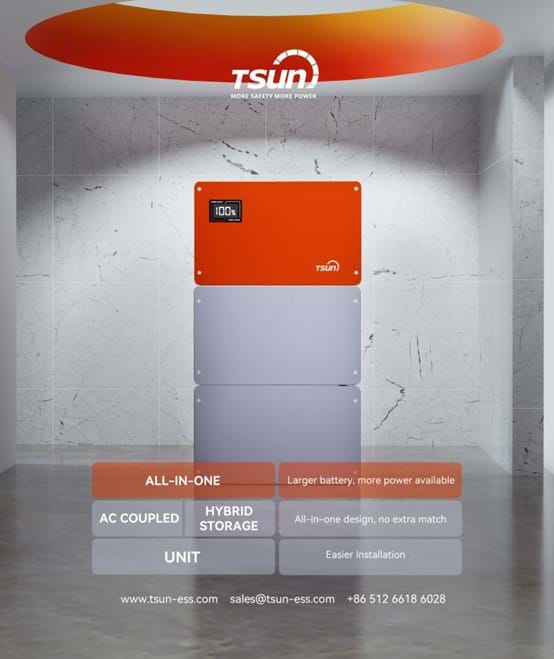Energy storage system, including solar modules, inverters, batteries, loads and other equipment. Currently, there are mainly two technical routes of DC coupling and AC coupling in the market.
AC or DC coupling refers to how solar panels are coupled or linked to a storage or battery system. The type of connection between the solar module and the battery can be either AC or DC. Most electronic circuits use DC power, with the solar module generating DC power and the battery storing DC power. However, most household appliances must run on AC power, so the type of connection between the solar module and the battery.
Hybrid storage system
Hybrid PV + energy storage system, that is, the DC power from the PV module, through the inverter, is directly stored in the form of DC power to the battery bank. The grid can also be converted through the hybrid inverter, DC charging to the battery. The convergence point of energy is at the DC battery end.
During the day, PV power is first supplied to the load, followed by charging the battery, and the energy storage system is connected to the grid so that the excess power can be grid-connected; at night, the battery is discharged to supply the load, and the shortage is supplemented by the grid; when the grid is out, PV power and lithium battery only supply power to the off-grid load, and the load at the grid-connected end cannot be used. When the load power is greater than the PV power, the grid and PV can supply power to the load at the same time. Because both PV power generation and load power are unstable, it depends on the battery to balance the system energy. In addition, the system also supports the user in setting the charging and discharging time to meet the user's electricity demand.

AC coupled storage system.
The coupled PV+storage system, also known as AC conversion PV+storage system, can realize that the DC power from PV modules is converted into AC power by grid-connected inverter. Then the excess power is converted into DC power and stored in the battery by AC coupled storage inverter, and the energy convergence point is at the AC end. It contains PV power supply system and battery power supply system. The PV system consists of PV modules and grid-connected inverter, and the energy storage system consists of the battery bank and AC-coupled inverter. These two systems can either operate independently without interfering with each other or can be separated from the grid to form a microgrid system.

AC-coupled systems are 100% grid compatible, easy to install and easily expandable. Standard home installation components are available, and even relatively large systems (2KW to MW class) are easily expandable. They can be combined with grid-tied and stand-alone generator sets (diesel sets, wind turbines, etc.).
Most string inverters above 3kW have dual MPPT inputs so that PV modules can be mounted from different orientations and tilt angles. At higher DC voltages, AC-coupled installation of large systems is easier and less complex than DC-coupled systems that require multiple MPPT charge controllers and, therefore, less costly.
AC coupling is suitable for system modification, and it is more efficient to use AC load during the daytime. It can transform the existing grid-connected PV system into energy storage system with low input cost. It can provide customers with safe power security during grid outages and is compatible with grid-connected PV systems of different manufacturers. Meanwhile, advanced AC coupled systems are typically used for larger-scale off-grid systems and use string solar inverters in combination with advanced multi-mode inverters or inverters/chargers to manage the batteries and grid/generators. Despite the relatively simple and powerful setup, they are slightly less efficient (90-94%) at charging batteries than DC-coupled systems (98%). However, these systems are more efficient when powering high AC loads during the day, reaching 97% or more, and some can be expanded with multiple solar inverters to form microgrids.
TSUN Energy Storage Solution
TSUN recently launched hybrid energy storage system and AC coupled energy storage system, respectively. It is understood that the 2 systems adopt the same style of modular integrated design, IP65 protection, suitable for indoor and outdoor scenarios installation; equipped with clear and easy-to-read LCD display, users can monitor through the App & Web Portal; the whole machine contains inverter, battery pack and pre-wired BMS system, only in the inverter side of the different distinction.

Hybrid energy storage system is equipped with Hybrid inverter, which can meet the demand of PV+storage in one, and is suitable for users who want to equip photovoltaic storage system at one time.
The AC coupling system is equipped with AC coupling inverter to meet customers' needs for direct AC energy storage or adding energy storage system on top of PV system. Equipped with LiFePO4 battery, safe and reliable, flexible battery capacity expansion (5~20kWh) and advanced battery management technology can extend battery life. Includes zero feed-in function for a variety of scenarios.